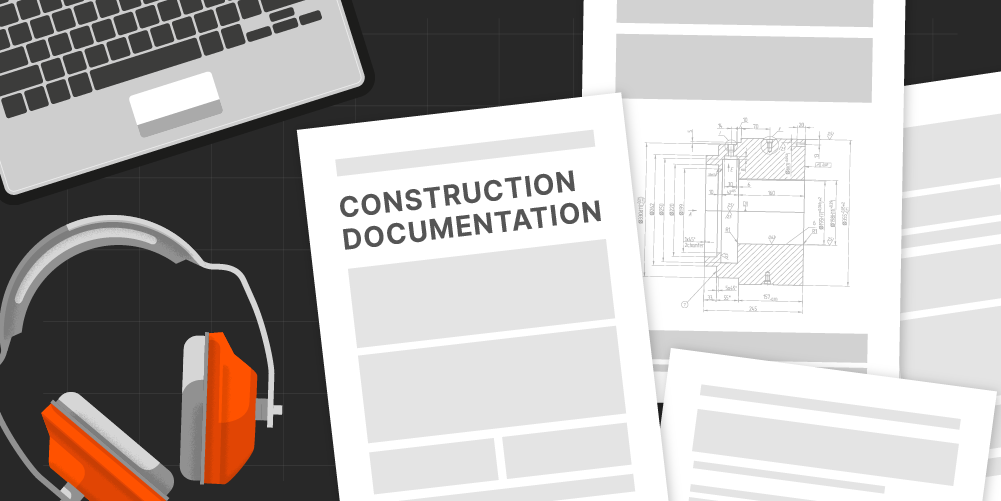— 7 min read
The Ultimate Guide to Construction Reporting in Australia
Last Updated Mar 27, 2025
Last Updated Mar 27, 2025

In commercial construction, structured reporting is essential for tracking progress, managing costs, ensuring safety, and mitigating risks. Regular, standardised reports help project managers keep construction projects on schedule and compliant. This guide explores the role of construction reporting in project success, the most common types of reports, and how digital tools are transforming reporting by making data collection and distribution more efficient.
Table of contents
What is Construction Reporting?
Construction reporting involves structured documentation of project progress, finances, risks, and compliance. These reports keep key stakeholders informed about timelines, budgets, and overall performance.
Without structured reporting, projects can face delays, budget overruns, and disputes due to missing approvals, uncontrolled costs, and poor documentation.
Why is Construction Reporting Important?
Effective construction reporting keeps project stakeholders informed and ensures they stay aligned with their role-specific responsibilities.
- For general contractors, reporting is critical to risk mitigation, subcontractor performance management, and compliance with National Construction Code (NCC) and Safe Work Australia regulations.
- For owners, it supports quality assurance, cost control, and transparency in project progress and financial health.
- For subcontractors, reporting verifies completed work, tracks compliance, and improves communication.
Improving Decision-Making and Reducing Disputes with Accurate Reports
Stakeholders can make informed decisions about risk management, resource allocation, and scheduling by using real-time project data. A well-maintained reporting system also helps prevent disputes by creating a verifiable record of milestones, safety incidents, financial transactions, and contract variations.
For example, a project manager reviewing daily site reports may notice a delay in material deliveries. With this insight, they can:
- Adjust work schedules to minimise downtime
- Source alternative suppliers
- Reallocate labour to avoid downtime.
Similarly, if a subcontractor disputes a payment, site reports and change orders provide a clear record of completed work. If an inspection flags a non-compliant fire safety issue, it can be addressed before certification, avoiding costly rework.
Accurate reporting ensures transparency, accountability, and proactive issue resolution, ultimately improving project outcomes. Accurate reporting ensures transparency, accountability, and proactive issue resolution, ultimately improving project outcomes.
What’s Included in a Construction Report?
Construction reports vary by type, but most provide a structured record of project progress, risks, and financials and capture relevant data for decision-making. Common elements include:
- Project details: Site name, project stage, responsible parties
- Progress tracking: Tasks completed, pending work, deviations from schedule
- Financial updates: Budget allocations, expenses, variations
- Safety and compliance: Incident records, inspections, risk assessments
- Resource utilisation: Equipment logs, workforce tracking, material usage
- Issues and resolutions: Risks identified and corrective actions taken
A well-structured report isn’t just about documentation—it’s a tool for keeping teams aligned, managing risks, and ensuring accountability.
Construction Reporting Requirements
The level of reporting depends on contractual obligations and the project’s risk profile. Some reports are mandatory, while others are best practices that help teams prevent costly setbacks.
- Contractual requirements: Many contracts specify reporting frequency and content, particularly for progress tracking, safety compliance, and financial oversight. Government-funded projects, may require environmental impact assessments, while private developments focus on cost reports for investor transparency.
- Risk management best practices: Teams often implement additional reporting such as equipment logs to track maintenance and daily site reports to document work completion and prevent payment disputes.
Smart reporting goes beyond compliance—it enables proactive decision-making, minimises delays, and protects profitability.
How Do Project Size and Type Impact Reporting Requirements?
Reporting in construction scales with the size, complexity, and risk profile of a project. Larger, more complex projects—such as hospitals, multi-storey office buildings, and shopping centers—demand comprehensive reporting to manage multiple stakeholders, strict regulations, and higher financial risks.
Pro Tip
For large, complex projects, maintain clear and consistent reporting with key documents like daily construction reports, safety reports (including job risk assessments -JRAs, and site inspections), environmental reports for planning and sustainability compliance, and financial reports covering WIP, cost management, and budget tracking.
Smaller projects, such as warehouses or low-rise residential builds, typically require fewer reports. A daily site diary and basic schedule report may suffice, with safety documentation being mandatory. Additional reports can always be requested for greater oversight.
Who Requests and Pays For Construction Reporting?
Owners request progress and financial reports to track milestones, budget usage, and scope variations for transparency and investment performance.
Head contractors oversee site operations and require safety reports, job risk assessments (JRAs), and daily updates from subcontractors to manage compliance, productivity, and risk.
Government regulators may mandate specific reports, such as environmental impact assessments or incident logs, depending on the project.
Who Pays for Reporting?
Typically, the party responsible for preparing the report covers the cost. Subcontractors pay for JRAs, while head contractors cover costs financial updates. If a report is required for government approval, the responsible party listed in the permit or license absorbs the cost.
Types of Construction Reports
Progress Reports
Progress reports track project milestones, delays, and upcoming work to keep all stakeholders aligned. Common formats include:
- Site Diary / Daily Construction Report (DCR): A daily log capturing site activities, workforce attendance, material deliveries, equipment usage, site conditions, and weather.
- Defects List: A list of outstanding tasks that must be completed before final project handover.
- Schedule Report: Compares planned vs. actual progress, highlights milestone completions, and documents delays with reasons.
- Look-Aheads: Forecasts work for the next 2-3 weeks to help teams allocate crews, materials, and equipment efficiently.
Safety Reports
These reports help mitigate risks, maintain compliance with Safe Work Australia regulations, and enhance site safety.
- Incident Log: Records workplace incidents, including injuries, near misses, and property damage.
- Job Risk Assessment (JRA): Identifies hazards, assesses risks, and outlines mitigation strategies.
- Site Inspection Report: Documents site conditions, safety compliance, and regulatory adherence—used for audits and quality control.
- Toolbox Talks: Summarises regular on-site safety meetings that address current hazards, past incidents, and upcoming high-risk activities (e.g., multiple crane lifts).
Financial Reports
These reports provide real-time financial visibility to prevent budget overruns.
- Work in Progress (WIP) report: Tracks project completion percentage, total costs incurred, and remaining expenses.
- Cost management report: Offers a detailed breakdown of expenditure, budget variances, and projected costs.
Environmental Impact Report
Required for projects that must comply with environmental laws such as the Environment Protection and Biodiversity Conservation Act 1999 (EPBC Act) and the Water Act 2007. It includes:
- Impact Assessment: Evaluates how construction affects the environment.
- Waste & Recycling Management: Documents disposal and sustainability efforts.
- Regulatory Compliance: Confirms adherence to environmental standards.
- Mitigation Measures: Details steps to prevent pollution, control erosion, and protect wildlife.
Quality Report
A quality assurance tool that evaluates workmanship and compliance with project specifications. It includes:
- Quality Control (QC) Measures: Inspections, testing, and monitoring protocols.
- Inspection & Testing Results: Summarised outcomes of on-site quality checks.
- Non-Conformance Reports (NCRs): Documentation of deviations from standards.
- Corrective Actions: Steps taken to resolve quality issues.
Handover/Closeout Report
The final handover package that officially transfers the project from the contractor to the owner. It includes:
- Project Summary & Scope of Work
- As-Built Drawings
- Final Inspection & Compliance Records
- Defect List Resolutions
- Operational & Maintenance Manuals
- Health & Safety Files
- Final Financial Report
Best Practices for Effective Construction Reporting
Standardise report formats.
Using templates and standardised documents ensures every report follows a uniform structure. This consistency makes it easier to extract key insights, track project progress over time, and ensure important data is not missed. Standardisation also simplifies file organisation, streamlines communication, and accelerates decision-making by reducing the time spent interpreting reports.
Leverage construction management software.
Digital tools centralise reporting, eliminate lost documentation, and enable real-time updates from the field. Automated data collection and report generation, reduces human error and ensures timely submissions. Smart alerts means teams can address critical issues as soon as they arise.
Train teams on accurate and timely documentation.
Provide clear guidelines and encourage real-time submissions through mobile reporting tools to improve accuracy. Specifying that the site diary should include visual evidence like photos and videos can provide much-needed context.
Ensure accessibility and collaboration across teams.
Store all reports in a centralised system for easy access and updates. Integrating reporting with project management software improves decision-making across teams.
Construction reporting helps track progress and ensure compliance.
Effective construction reporting is essential for tracking progress, managing costs, and ensuring compliance in Australian commercial projects. Standardised processes and digital tools enhance collaboration and streamline reporting, helping construction teams stay efficient and profitable.
Categories:
Tags:
Written by
Samantha Nemeny
9 articles
Sam—Samantha if she’s feeling particularly academic—has spent a decade in content marketing, with eight years focused on Australia’s construction industry. She has a knack for making complex ideas easy to understand, turning industry jargon into clear, engaging stories. With a background in SEO and marketing, she’s spent the past three years at Procore, helping industry professionals navigate the world of construction with content that’s both insightful and easy to digest.
View profileExplore more helpful resources

Document Control, Mastered: Blueprints, Binders & the Cloud
In construction, poor document control is more than a hassle—it’s a liability. Mismanaged documents can delay builds, drive up costs, and cause security and compliance issues. It’s a challenge facing...

Construction Progress Claims: Keeping Cash Flowing
In construction, steady cash flow is critical—and progress claims help make that possible. These claims enable staged payments based on work completed, rather than waiting until project completion. In this...

Construction Analytics: The Key to Smarter Decision-Making
Data is everywhere in construction—embedded in schedules, site activity logs, safety reports, and cost tracking tools. Yet despite the abundance of available information, many construction decisions still hinge on gut...

Construction Document Management: The Challenges and Benefits of Embracing a DMS
Every construction project begins, continues, and ends with a mountain of paperwork. From initial bidding documents to contractor agreements, blueprints, variation orders, inspection reports, on and on it goes. And...